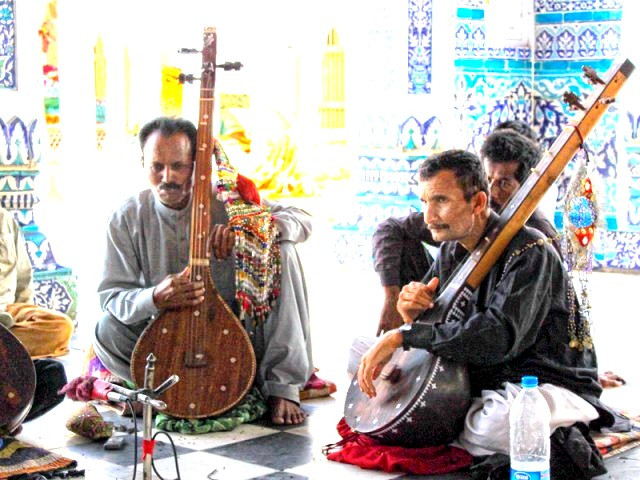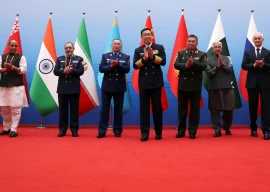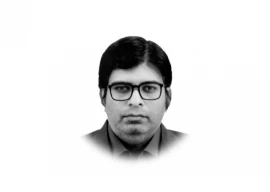
But my mother told me I had to be patient. According to her, I couldn’t just pack my bags and go. I had to wait for a ‘bulawa’. I had to wait for the calling. So, I waited…
I waited for Sacchal Sarmast. I waited for Shah Abdul Latif Bhittai. I waited for Misri Shah, Baba Farid and Data Sahib to invite me for a visit.
But nothing happened.
As life went on, I pushed the pirs and mazaars to the back of my mind. However, last week, a friend proposed a road trip. She had some work to do in Hyderabad and told me that we could explore the cities or shop after it was done. Obviously, I tagged along.
The drive from Hyderabad to Bhit Shah takes about 40 to 45 minutes. My mind buzzed with excitement as the car drove past the blue gates to the bazaar. I was finally going to meet Bhittai.
The car stopped at the foot of the mazaar – an unimposing, single-story structure. I climbed the stairs and was greeted by a man who has been selling flowers, chadors, dhagas and dry fruit there for more than 30 years. I left my slippers at the entrance, covered my head and walked towards the courtyard which looked like it was glowing.
But it wasn’t. It was steaming like an oven. The white marble courtyard was on fire. I had to hop from one place to another to avoid getting burnt. A sympathetic policeman took pity on me and offered to take me to a well. He said that it had the sweetest water that attracted people from far and wide who wanted their wishes to come true. “I wouldn’t recommend you drink it,” he warned, however. “Sometimes people are careless and throw rubbish in it too.”
As he walked and I hopped, we reached the other side of the courtyard where women brought food and offerings after their prayers were granted.
Peaceful meditations
A group of fakirs arrives after Zuhr each day to offer ‘hazari’ by reciting poetry and qawalis in Bhittai’s honour. Other devotees include people who tied a thread, rope or padlock to a 300-year-old tree next to the dargah’s mosque in the hope that what they have asked for will come true. Once the manaat is complete, the people return no matter what to untie the thread or unlock the lock.
Some people sacrifice goats and cows in a corner of the courtyard. On the 14th of every month when the new moon comes, men and women flock to the mazaar with wooden sticks. They light a big fire in the middle of the courtyard and throw the sticks in as a symbol of what they prayed for. Most of the devotees come from Jacobabad, Sukkur and Khairpur, and many pay a visit every Thursday.
The mausoleum
Our next stop was the takht gah, a single-storey structure with green gates and a small courtyard. It is rumoured that Bhittai used to pray, meditate and write here every day.
But it was in front of the mausoleum that I was awestruck. The traditional blue Kashi tiles stand out in sharp contrast to the icy-white floor. Unlike Lal Shahbaz Qalandar’s dargah, which is often described as hot owing to the saint’s temperament, Bhittai’s shrine is the epitome of cool. I offered my fateha at the grave, which was encased in beautiful woodwork. The taj, placed on top of the site, glittered with gold and intricate threadwork.
The gaddi nasheen and his family are responsible for changing the flowers and chador twice a day. If you look closely you will see a little mark on the wood which indicates Bhittai’s date of birth. There are other elements that may at first not strike you, such as the doors, which the policeman pointed out, were made of pure silver. In fact, with a wide grin on his face, he told me that the doors and their paneling were original as done by Mian Ghulam Shah Kalhoro.
He also pointed out that one of the main domes of the mausoleum is topped with gold - but no one has ever tried to steal it. “Bhittai taught these people to love and care. He gives them a place to rest and pray when the world turns its back on them,” he said. “Why would anyone want to steal from him? As soon as you enter the dargah and hold your hands up to offer Fateha, you are his.”
Who was Shah Abdul Latif Bhittai
Born into a well-respected family in 1689 in a village near Bhit Shah, which was later named after him. Bhittai did not want to indulge in luxury.
He wanted to live the simple life and appreciate nature. He was Sufi scholar, mystic, saint, poet and musician.
He was known for wearing saffron robes and possessing a calm temper. He died in 1752 and his urs is celebrated in the Islamic month of Safar.
Published in The Express Tribune, April 19th, 2012.


















COMMENTS
Comments are moderated and generally will be posted if they are on-topic and not abusive.
For more information, please see our Comments FAQ